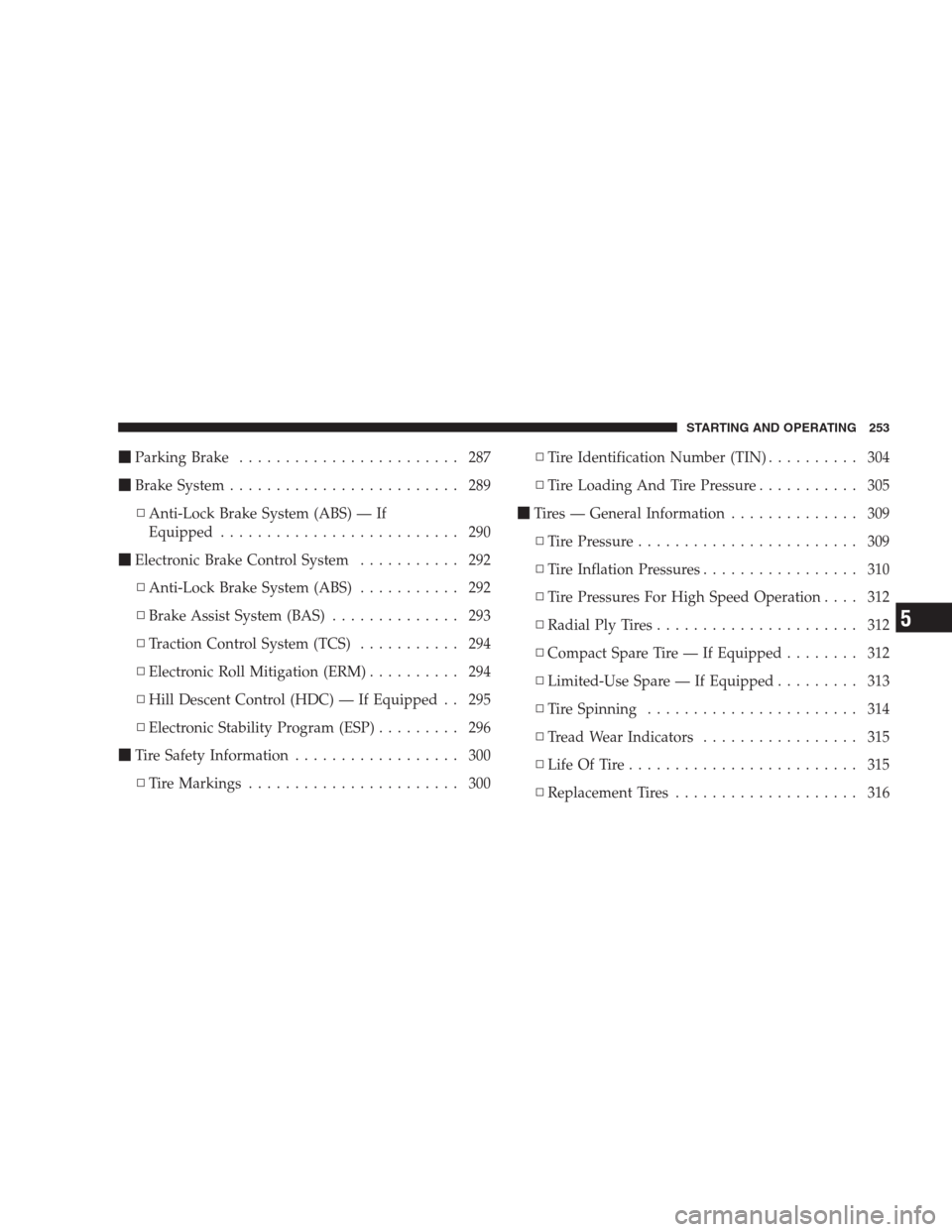Page 255 of 457

�Parking Brake........................ 287
�Brake System......................... 289
▫Anti-Lock Brake System (ABS) — If
Equipped.......................... 290
�Electronic Brake Control System........... 292
▫Anti-Lock Brake System (ABS)........... 292
▫Brake Assist System (BAS).............. 293
▫Traction Control System (TCS)........... 294
▫Electronic Roll Mitigation (ERM).......... 294
▫Hill Descent Control (HDC) — If Equipped . . 295
▫Electronic Stability Program (ESP)......... 296
�Tire Safety Information.................. 300
▫Tire Markings....................... 300▫Tire Identification Number (TIN).......... 304
▫Tire Loading And Tire Pressure........... 305
�Tires — General Information.............. 309
▫Tire Pressure........................ 309
▫Tire Inflation Pressures................. 310
▫Tire Pressures For High Speed Operation.... 312
▫Radial Ply Tires...................... 312
▫Compact Spare Tire — If Equipped........ 312
▫Limited-Use Spare — If Equipped......... 313
▫Tire Spinning....................... 314
▫Tread Wear Indicators................. 315
▫Life Of Tire......................... 315
▫Replacement Tires.................... 316
STARTING AND OPERATING 253
5
Page 288 of 457

POWER STEERING
The standard power steering system will give you good
vehicle response and increased ease of maneuverability
in tight spaces. The system will provide mechanical
steering capability if power assist is lost.
If for some reason the power assist is interrupted, it will
still be possible to steer your vehicle. Under these condi-
tions, you will observe a substantial increase in steering
effort, especially at very low vehicle speeds and during
parking maneuvers.
NOTE:Increased noise levels at the end of the steering
wheel travel are considered normal and do not indicate
that there is a problem with the power steering system.
Upon initial start-up in cold weather, the power steering
pump may make noise for a short amount of time. This is
due to the cold, thick fluid in the steering system. This
noise should be considered normal, and it does not in any
way damage the steering system.WARNING!
Continued operation with reduced power steering
assist could pose a safety risk to yourself and others.
Service should be obtained as soon as possible.
CAUTION!
Prolonged operation of the steering system at the end
of the steering wheel travel will increase the steering
fluid temperature and it should be avoided when
possible. Damage to the power steering pump may
occur.
Power Steering Fluid Check
Checking the power steering fluid level at a defined
service interval is not required. The fluid should only be
checked if a leak is suspected, abnormal noises are
286 STARTING AND OPERATING
Page 301 of 457

In this mode, ESP is turned off until the vehicle reaches a
speed of 35 mph (56 km/h). At 35 mph (56 km/h) the
system returns to “Partial Off” mode, as described above.
When the vehicle speed drops below 30 mph (48 km/h)
the ESP system shuts off. ESP is deactivated at low
vehicle speeds so that it will not interfere with off-road
driving however, ESP function returns to provide the
stability feature at speeds above 35 mph (56 km/h). The
“ESP Indicator Light” will always be illuminated when
ESP is off.
To turn ESP on again, momentarily depress the ESP OFF
switch. This will restore the “ESP On” mode of operation.
NOTE:The “ESP OFF” message will display and an
audible chime will sound when the shift lever is placed
into the PARK position from any other position, and then
moved out of the PARK position. This will occur even if
the message was previously cleared.WARNING!
With the ESP switched off, the enhanced vehicle
stability offered by ESP is unavailable. In an emer-
gency evasive maneuver, the ESP system will not
engage to assist in maintaining stability. “ESP Off”
mode is intended for off-highway or off-road use,
only.
ESP/BAS Warning Light and ESP Indicator Light
The malfunction indicator for the ESP is combined with
the BAS indicator. The yellow “ESP/BAS Warning Light”
and the yellow “ESP Indicator Light” in the instrument
cluster both come on when the ignition switch is turned
to the ON position. They should both go out with the
engine running. If the “ESP/BAS Warning Light” comes
on continuously with the engine running, a malfunction
has been detected in either the ESP or BAS system, or
both. If this light remains on after several ignition cycles,
STARTING AND OPERATING 299
5
Page 439 of 457

Autostick............................. 264
Battery............................... 373
Keyless Transmitter Replacement (RKE)....... 25
Body Mechanism Lubrication............... 375
B-Pillar Location........................ 305
Brake Assist System...................... 293
Brake Fluid............................ 406
Brake, Parking.......................... 287
Brake System........................289,384
Anti-Lock (ABS)....................290,292
Master Cylinder....................... 384
Parking............................. 287
Warning Light........................ 170
Brakes.............................289,384
Brake/Transmission Interlock............... 261
Break-In Recommendations, New Vehicle........ 68
Bulb Replacement.....................397,398
Bulbs, Light............................ 397Capacities, Antifreeze (Engine Coolant)........ 404
Capacities, Fluid........................ 404
Caps, Filler
Fuel............................... 332
Oil (Engine).......................365,371
Power Steering........................ 286
Car Washes............................ 389
Carbon Monoxide Warning................. 332
Cargo Area Cover....................... 155
Cargo Area Features...................... 154
Cargo Compartment
Light............................... 154
Luggage Carrier....................... 159
Cargo Light............................ 154
Cargo Load Floor........................ 156
Cargo Tie-Downs........................ 156
Caution, Exhaust Gas...................... 69
Cellular Phone........................81,242
Center High Mounted Stop Light............ 402
INDEX 437
10